Melbourne to Sydney in 2 hours - by train!
This is a proposal for a Melbourne - Sydney high speed Maglev Monorail with a link to Canberra from Yass.
Express Melbourne-Sydney travel time is likely to be about 2 hours with stops at Albury and Yass. Stopping all stations trains would take about 2.5 hours.
Trains would travel below 250 km/h in urban areas but up to 500 km/h in the country. Sound barriers would keep noise levels similar to existing freeway and railway noise levels.
Approximate Route within 30 km
The approximate route of the proposed 800 km Melbourne Airport to Sydney Maglev is shown below.
While the road distance is about 850 km this can be cut to about 800 km with some straightening.
Infrastructure Australia has proposed a route taking in Sheparton and Wagga Wagga which would be 824 km which could also be used by a maglev.
|
View Melbourne - Sydney in a larger map Approximate route of the Melbourne - Sydney Maglev from Melbourne Airport Maglev Link to Sydney Town Hall. |
Maglev Route Details
Melbourne
The Melbourne-Sydney maglev would be a continuation of the 27 km / 8 minute Melbourne Airport Maglev Link.
Melbourne - Sydney
The Melbourne-Sydney maglev track could largely follow the Hume Highway / Freeway with some smoothing off of corners in places to straighten the track or follow the Infrastructure Australia route via Sheparton and Wagga Wagga.
Yass
At Yass passengers could transfer to a single-track shuttle service to Canberra which would take about 10 minutes.
Campbelltown to Sydney Approach
At the south-east edge of greater Sydney the maglev track runs to a new maglev station adjacent to the existing Campbelltown station which allows interchange with many Sydney rail services. This details is not shown on map. From there the track follows the M5 East Freeway until the tunnel portal.
Sydney Maglev Tunnel
This runs for 17 km from M5 East Freeway tunnel portal to north of St Leonard Station with one maglev underground station linked to the existing Wynyard Station. This allows maglev trains to run at below 120 km/h into the Sydney CBD from the north or south.
Maglev Stations and Operation
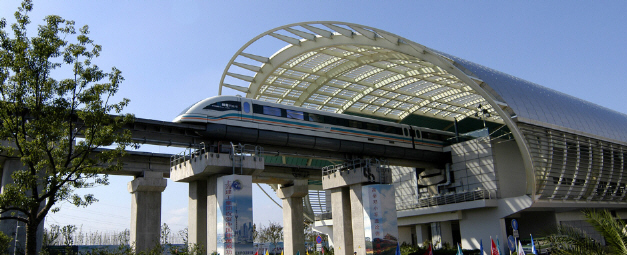
A Shanghai maglev station. |
Stations are suggested at the following locations. These stations should be built to accommodate trains of up to ten carriages which requires the platforms to be 260 meters long.
- Melbourne - Southern Cross: Provided as part of the Melbourne Airport maglev link. Interchange with all Victorian rail and coach services.
- Melbourne Airport: Provided as part of the Melbourne Airport maglev link.
- Seymour
- Wangaratta
- Albury
- Wagga Wagga: The map shows the main line running along the Hume Highway but it could deviate slightly to Wagga.
- Yass: Interchange for the Canberra shuttle.
- Goulburn.
- Sydney - Campbelltown: Interchange with all south-east Sydney rail services.
- Sydney - Wynyard: Sydney CBD and interchange with all Sydney rail services.
- Sydney - Chatswood: The maglev emerges from a tunnel north of St Leonards station and follows the rail lines to a station at Chatswood. Maglev trains would continue on to the Sydney-Newcastle extension if that was built.
The bold stations are for all trains, the other stations are used for off-peak services. The existing conventional railway would be used to provide the stopping-all-stations service and for heavy freight.
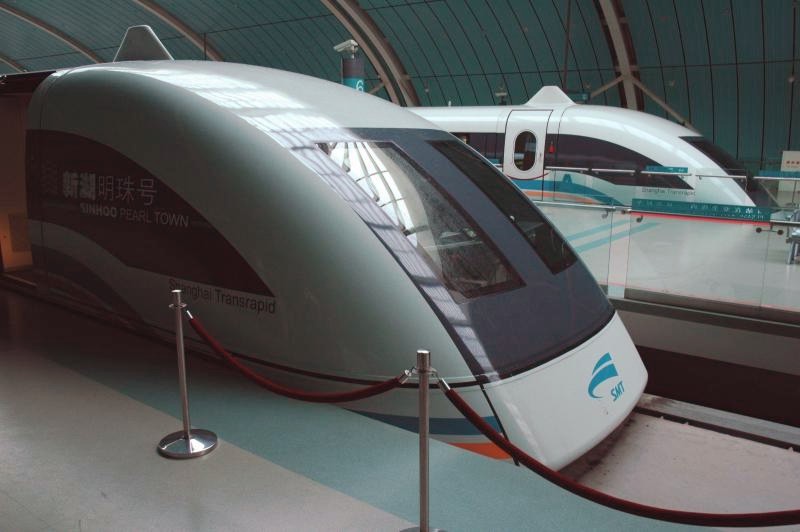
Shanghai Maglev Trains at Longyang Station (www.focusonmicroscopy.org ) |
Maglev Operation
On any two-track system it is difficult to safely alternate express and stopping-all-station services without reducing express services to the speed of the stopping-all-station service.
We suggest that maglev trains stop at all stations they approach between (say) 10:00 and 17:00 and run express for other times.
Note that conventional trains and road coaches would continue to provide a full stopping-all-station service including stops not serviced by the maglev.
Sydney Trains would run from Melbourne Southern Cross all the way to Chatswood. (Some trains may just shuttle to Melbourne Airport).
Maglev Station Layout
The proposed stations have three platforms each like those shown above. Passengers enter trains via the central platform boarding whichever train comes first. Departing passengers leave via whichever edge platform their train arrives next to. Exit side doors open first to allow passengers to start clearing the carriages on one side before passengers start boarding from the other side.
Maglev Trains
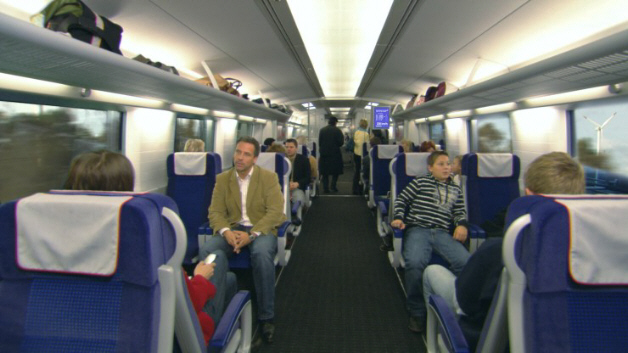
Transrapid TR09 interior. Note the 3.7 meter wide carriages. |
Initially trains could consist of just two end carriages. As passenger load increases up to eight central carriages can be added to create a train up to 10 carriages long. With a mixture of first and second class seating a ten-carriage train would carry about 900 passengers.
Maglev trains are fully automated. We would place the train operator in a central cabin allowing passengers to choose seats at the front of the train if they wished. Another option is to have the first and last carriages used for light freight and baggage.
Maglev Capital Cost
The initial capital cost would be between $30 and $40 billion for the dual-track, nine stations, trains and a tunnel at the Sydney end. The trains could be expanded to ten carriages later and service intervals can be reduced as demand increases. This excludes any land acquisition costs which can be minimized by mostly using the Hume Freeway reservation.
The biggest single cost element is the Sydney tunnel. Maglev's flexibility keeps tunnelling to only 17km and by keeping speeds down in this short section a smaller tunnel bore can be used.
This compares favourably with the cost of the National Broadband Network which is likely to exceed $40 billion.
Approximate Melbourne-Sydney Capital Cost
These are rough figures to give a general idea of cost only. Assumptions:
- Track distance is about 800 km from the end of the Melbourne Airport maglev link. (Road distance is ~840km).
- Dual-track is used.
- 50% of the track is elevated, 50% at about 1.5 meters.
- A $7 to $8 billion tunnel is needed at the Sydney end assuming tunnelling cost of about $500 million per kilometer. (Infrastructure Australia estimates tunnels only cost $170 per kilometre but the Victorian Government estimates them at $1 billion per kilometre).
- Eight stations are included.
- Trains consist of 50/50 1st class and 2nd class with no standing passengers.
- Average speed with stops is 420 km/h. (Stopping all stations trains would be slower).
- The single-track Yass-Canberra connect is not included - this would be another $1.3 Billion with a single 10-segment shuttle train.
- Times are Southern Cross station (Melbourne CBD) to Wynyard station ( Sydney CBD ).
- Costs are from Melbourne Airport end of the Melbourne Airport maglev link to Chatswood Station.
| Scenario |
CBD-CBD Travel time (hours) |
Headway (mins) | Number of Trains Needed |
Train Segments per train | Max Seated Pass. per hour per per direction | Max Seated Pass. per 18 hour day (thousands) |
Max Seated Pass. per month (million) |
Approx. Cost ($A Billion) |
|---|---|---|---|---|---|---|---|---|
| Current Air travel (www.bitre.gov.au/statistics/aviation) |
2 | - | - | - | - | - | 1.2 | - |
| Light Maglev | 2 | 20 | 12 | 4 | 1,080 | 38 | 1.2 | $31 |
| Medium Maglev | 2 | 10 | 20 | 6 | 3,240 | 116 | 3.5 | $32 |
| Maximum Maglev | 2 | 5 | 41 | 10 | 10,800 | 388 | 11.8 | $38 |
Maglev Freight
The above table shows that there is likely to be substantial space for light freight trains to operate on the same track. More freight trains could be scheduled to run in off-peak times. Additionally the first and last segments could be dedicated to carrying freight with the central segments carrying passengers.
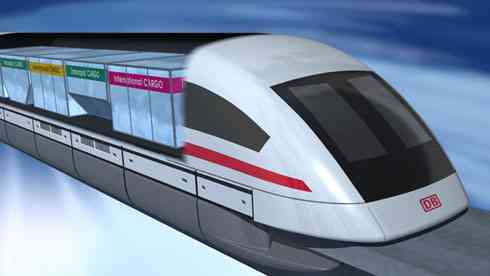
A cut-away image of a Transrapid maglev freight train. (Image: Transrapid) |
Sydney Rail Map
Expand this map to see how the maglev stations (coloured in red) at Town Hall, Chatswood and Hornsby would connect to the existing rail network. (Hornsby and Chatswood would be on the Sydney-Newcastle extention.)
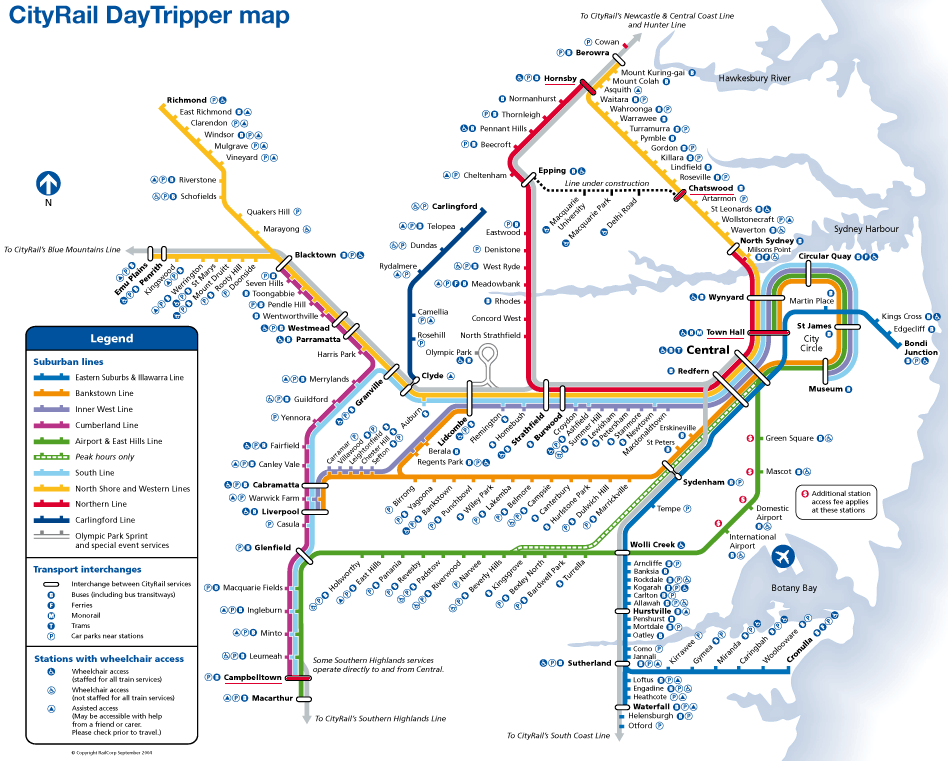
CityRail DayTripper map (Click to expand). |
